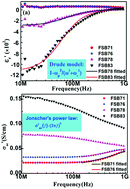Experimental realization of tunable negative permittivity in percolative Fe78Si9B13/epoxy composites
Abstract
Negative permittivity is one of the most important properties in the realization of double negative medium or negative index materials. In this paper, tunable negative permittivity in the radio frequency range has been obtained in composites with Fe78Si9B13 amorphous alloy dispersed in an epoxy matrix. The microstructure and dielectric properties of Fe78Si9B13/epoxy composites are investigated in detail. The results indicate that when the Fe78Si9B13 content is beyond the percolation threshold, the plasma oscillation of delocalized electrons in interconnected Fe78Si9B13 leads to negative permittivity. By controlling the effective concentration of free electrons, the negative permittivity of the Fe78Si9B13/epoxy composites could be easily adjusted. Additionally, the frequency dispersion behaviors of the conductivity conform to the Jonscher's power law below percolation threshold, demonstrating that the conductive mechanism is hopping conduction. The realization of tunable negative permittivity in Fe78Si9B13/epoxy composites gives a new and high-efficient way toward double negative materials.


 Please wait while we load your content...
Please wait while we load your content...